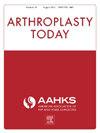Current Rates and Trends of Venous Thromboembolism After Total Hip and Knee Arthroplasty: An Updated Analysis Utilizing the NSQIP Database
IF 2.1
Q3 ORTHOPEDICS
引用次数: 0
Abstract
Background
Total hip arthroplasty (THA) and total knee arthroplasty (TKA) procedure volumes are increasing. Venous thromboembolism (VTE) remains a significant complication, with incidence rates between 0.45% and 5.30%. Enhanced rapid-recovery pathways and chemoprophylaxis evolution may correlate with decreased VTE events over time. This study analyzes recent trends of VTE after THA and TKA.
Methods
Adults undergoing THA or TKA between 2009 and 2022 were identified from the National Quality Surgical Improvement Program database using Current Procedural Terminology codes. VTE was defined as the occurrence of a deep vein thrombosis (DVT) and/or pulmonary embolism (PE) event in the same patient. The 30-day incidence data of VTE, DVT, and PE were trended over time. Multivariate regression analyses estimated the adjusted risk of events by year of surgery relative to 2009 and identified associated risk factors.
Results
A total of 382,515 THAs and 593,060 TKAs were included with 5713 DVTs and 3807 PEs observed. Trends of 30-day VTE decreased over the study period in THA (0.8%-0.5%, P < .001) and TKA (1.8%-0.9%, P < .001). Significant decreasing trends were observed for both DVT and PE following TKA (both P < .001) and for DVT (P < .001) following THA. Adjusted regression showed significantly lower odds of 30-day DVT (odds ratio 0.68, P < .01) and PE (odds ratio 0.59, P < .01) after TKA in 2022 compared to 2009.
Conclusions
The 30-day VTE incidence following THA and TKA has significantly decreased since 2009. Both DVT and PE have decreased in the TKA population, likely due to improved preoperative patient optimization and enhanced recovery pathways, despite shifts toward more selective antiplatelet chemoprophylaxis.
目前全髋关节和膝关节置换术后静脉血栓栓塞的发生率和趋势:利用NSQIP数据库的最新分析
背景:全髋关节置换术(THA)和全膝关节置换术(TKA)的手术量正在增加。静脉血栓栓塞(VTE)仍然是重要的并发症,发生率在0.45%至5.30%之间。随着时间的推移,快速恢复途径的增强和化学预防的演变可能与静脉血栓栓塞事件的减少有关。本研究分析了全髋关节置换术和全髋关节置换术后静脉血栓栓塞的最新趋势。方法2009年至2022年间接受全髋关节置换术或全髋关节置换术的成人使用现行程序术语代码从国家质量外科改进计划数据库中识别。静脉血栓形成(VTE)定义为同一患者发生深静脉血栓形成(DVT)和/或肺栓塞(PE)事件。VTE、DVT和PE的30天发生率随时间变化趋势。多变量回归分析估计了相对于2009年手术年份的调整后事件风险,并确定了相关的风险因素。结果共检查tha 382515例,tka 593060例,dvt 5713例,pe 3807例。THA患者30天静脉血栓栓塞趋势在研究期间下降(0.8%-0.5%,P <;.001)和TKA (1.8%-0.9%, P <;措施)。TKA后DVT和PE均有显著下降趋势(P <;.001)和深静脉血栓(P <;.001)。校正回归显示30天DVT发生的几率显著降低(优势比0.68,P <;0.01)和PE(优势比0.59,P <;与2009年相比,TKA后的2022年。01)。结论自2009年以来,THA和TKA术后30天静脉血栓栓塞发生率显著降低。在TKA人群中,DVT和PE都有所下降,这可能是由于术前患者优化和恢复途径的改善,尽管转向了更具选择性的抗血小板化学预防。
本文章由计算机程序翻译,如有差异,请以英文原文为准。
求助全文
约1分钟内获得全文
求助全文
来源期刊

Arthroplasty Today
Medicine-Surgery
CiteScore
2.90
自引率
0.00%
发文量
258
审稿时长
40 weeks
期刊介绍:
Arthroplasty Today is a companion journal to the Journal of Arthroplasty. The journal Arthroplasty Today brings together the clinical and scientific foundations for joint replacement of the hip and knee in an open-access, online format. Arthroplasty Today solicits manuscripts of the highest quality from all areas of scientific endeavor that relate to joint replacement or the treatment of its complications, including those dealing with patient outcomes, economic and policy issues, prosthetic design, biomechanics, biomaterials, and biologic response to arthroplasty. The journal focuses on case reports. It is the purpose of Arthroplasty Today to present material to practicing orthopaedic surgeons that will keep them abreast of developments in the field, prove useful in the care of patients, and aid in understanding the scientific foundation of this subspecialty area of joint replacement. The international members of the Editorial Board provide a worldwide perspective for the journal''s area of interest. Their participation ensures that each issue of Arthroplasty Today provides the reader with timely, peer-reviewed articles of the highest quality.
 求助内容:
求助内容: 应助结果提醒方式:
应助结果提醒方式:


